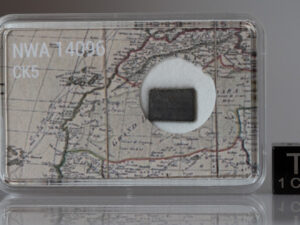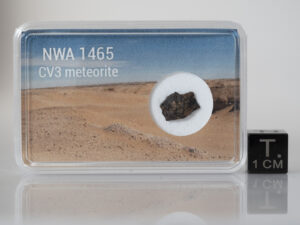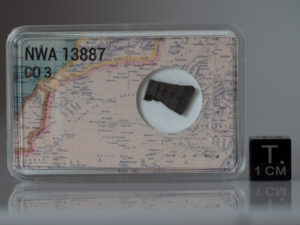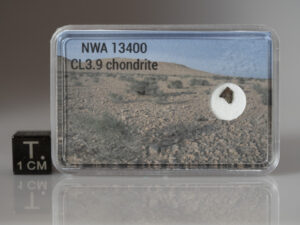Description
Writeup from MB 109:
Northwest Africa 13400 (NWA 13400)
(Northwest Africa)
Purchased: 2016 Dec
Classification: Carbonaceous chondrite (C3, ungrouped)
Petrography: (K. Metzler, IfP) Carbonaceous chondrite, consisting of closely packed, metal-bearing chondrules (apparent size up to 2.8 mm), chondrule fragments, and CAIs (apparent size up to 3.8 mm) with low amounts of interchondrule matrix (17 vol%). The mean apparent chondrule size is 480 µm (n=512).
Geochemistry: Mineral compositions and geochemistry: The mean olivine composition is Fa14.7±1.3 (Fa10.2-16.0, n=30); the mean low-Ca pyroxene composition is Fs6.6±3.7Wo1.0±0.1 (Fs1.2-15.9Wo0.8-1.2, n=20). Oxygen isotopic composition (R. Greenwood, OU): δ17O=-4.017‰, δ18O=-0.021‰, Δ17O=-4.006‰.
Classification: Carbonaceous chondrite (ungrouped). Petrologic type 3.9 based on the percentage mean deviation (PMD) of Fa values (8.8%). Classified as ungrouped due to the low mean Fa and Fs values of olivine and low amount of matrix compared to e.g., CV chondrites. Chondrule size does not fit with either CV, CK or CK chondrites that are the closest groups in terms of oxygen isotopic composition.
Writeup from MB 110:
Northwest Africa 13400 (NWA 13400)
(Northwest Africa)
Find: 2016
Revised classification and description. CL3.9
Physical characteristics: Carbonaceous chondrite with high chondrule abundance (76 vol%) and low amounts of fine-grained matrix (17 vol%). Composed of irregularly formed Type-I chondrules, few Type-II chondrules, refractory inclusions (CAIs, AOAs), inter-chondrule metal and sulfide grains and matrix. Contains high amounts of (partly terrestrially oxidized) metal (magnetic susceptibility log χ (× 10-9 m3/kg) = 4.78). Fragments of chondrules and refractory inclusions occur, but macroscopically this sample is unbrecciated. It is of shock stage C-S2 and has a weathering grade of W2/3.
Geochemistry: Bulk Ti and Cr isotopic composition: ε50Ti ± 2σ = 2.60±0.07; ε54Cr ± 2σ = 0.70±0.13.
Classification: Due to its characteristically low amount of matrix, highly depleted concentrations of volatile elements, high magnetic susceptibility, low Fa values of nearly equilibrated olivine, and unique position in the ε50Ti-ε54Cr diagram, this sample was reclassified as a CL3.9 chondrite by Metzler et al. (2021).





